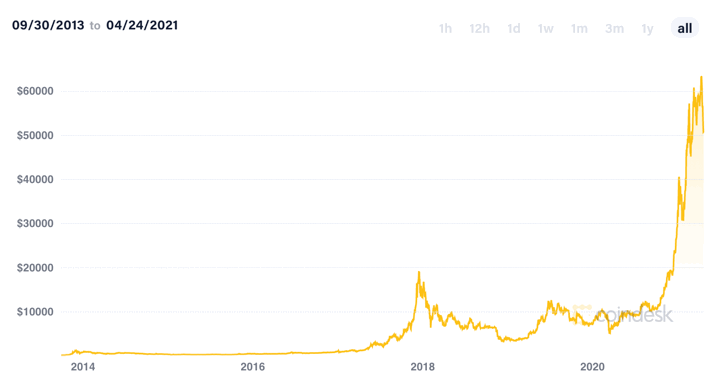 As an extension of High-Yield Crypto Accounts: 6% Interest in Bitcoin or 9% Interest on Stablecoin, I’m trying to better understand the potential scenarios that might cause loss of principal. Even if you’re tired of crypto talk, you should be aware that newer “savings account” apps exist that advertise high interest rates to mainstream customers while playing down their lack of FDIC-insurance and reliance on cryptocurrency markets.
As an extension of High-Yield Crypto Accounts: 6% Interest in Bitcoin or 9% Interest on Stablecoin, I’m trying to better understand the potential scenarios that might cause loss of principal. Even if you’re tired of crypto talk, you should be aware that newer “savings account” apps exist that advertise high interest rates to mainstream customers while playing down their lack of FDIC-insurance and reliance on cryptocurrency markets.
Traditional bank lender model. You deposit your cash into a bank. The bank lends that money out for things like business loans and mortgages, charging them interest. The bank passes on some of the interest to you, and keep the rest as profits for itself. However, if the bank makes enough bad loans, it may not be able to pay the interest or even return all of your deposits. Even so, FDIC insurance will cover deposits up to $250,000 per titled account. This means we don’t have the burden of independently evaluating the quality of every bank. This safety net is critical.
Stablecoin lender model. Traditional banks will not loan out money to people want to put up Bitcoin as collateral. However, there is heavy demand by people with bitcoin/crypto to access cash without actually selling their bitcoin/crypto. Since the big banks are not competing and it’s a risky business, the interest rates charged are high. They have to pay you 8% interest because it’s the only way they can come up with enough cash to fund these loans. If they could get it cheaper elsewhere, don’t you think they would?
For example, BlockFi requires you to put up $200 of BTC for every $100 that you borrow (50% loan-to-value). The idea is that if they don’t pay back the loan on time, BlockFi can just sell the BTC. BlockFi may also sell the BTC anyway if the value drops enough and you don’t post more collateral:
If the value of your collateral significantly decreases, a crypto margin call may occur. Crypto margin calls are calculated based on the LTV (loan-to-value) rate outlined in your loan agreement. A margin call can happen when the value of your collateral drops, increasing the LTV of your loan.
In the event of a margin call, you will have to add more collateral to your account to maintain a healthy LTV ratio. The first margin call occurs at a 70% LTV. At this point, you have 72 hours to take action by posting additional collateral or paying down the loan balance. We will keep you informed if your LTV starts to near the 70% mark so you can take action preemptively.
If your LTV reaches the 80% mark, BlockFi will automatically sell a portion of your crypto collateral to bring your LTV back to a 70% LTV.
Loss scenario: Rapid BTC price drop. BTC prices might drop so steeply (more than 50%) and suddenly (no market liquidity) that BlockFi is unable to liquidate the BTC collateral in time. If they recover less than the original loan amount, and the total losses across their loans are great enough, and they don’t get other backup funding, they may not have the funds to pay back your cash deposits. The price of 1 BTC is $50,000 today, but less than a year ago it was under $10,000, so such a drop is not inconceivable (source):

Loss scenario: Stablecoin price dropping below $1. Stablecoins are supposed to be backed by an equal amount of real money held in a trust account. Right now, the trading price of 1 USDC = $1.00. USDC is issued by Coinbase (now a large publicly-traded company) and is audited monthly by well-known US auditor Grant Thornton LLP that their dollar balances are at least equal to the number of USDC outstanding. However, in the past Tether (USDT), another stablecoin, has had credibility issues regarding its reserves and its price has dropped to as low as $0.88 in the past. Tether was accused of quietly using its cash reserves to help shore up its other struggling businesses. For any stablecoin, if there is even a perceived risk that it is not fully backed by actual US dollars, the price of a stablecoin may drop below the $1.00 peg, which means a loss of principal if you have to sell/withdraw at that price.
Loss scenario: Hacking, accidental loss, and/or internal fraud. There are has been a long history of hacks that have resulted in the theft of many millions of dollars in crypto. Any major loss could bankrupt a company, with obviously some being more vulnerable than others. Coincheck was hacked for $500 million. Per CNBC, the “Canadian crypto exchange QuadrigaCX went bankrupt after its CEO died in 2019, resulting in millions of dollars’ worth of digital assets being trapped in a digital wallet.” This type of thing is why traditional banks don’t want to deal with holding actual cryptocurrency keys. You could view BlockFi’s role as being paid to take on the risk of hacked wallets, lost passwords, and liquidity crunches. As a stablecoin depositor, you are also indirectly making your interest by taking on these risks.
Loss scenario: Drop in interest spreads. This NotBoring longread by Packy McCormick explains in detail why hedge funds are using BlockFi to leverage up their Bitcoin futures arbitrages. This results in a huge demand by these large institutions and a willingness to pay high interest rates. However, as times goes on, these arbitrages will eventually dry up. In the best-case scenario, this will just result in a gradual lowering of interest rates. In a worst-case scenario, a rapid loss of revenue could lead to business failure.
Loss scenario: Sudden government regulation. While part of the allure of cryptocurrencies is the lack of direct government control, the regulation of cryptocurrencies still matters greatly. Just last week, Turkey banned the use of cryptocurrencies for purchasing goods and services. Immediately afterward, Turkish crypto exchange Thodex shut down and $2 billion of investor funds are allegedly missing. Regulation could directly impact these businesses by banning their operations, or indirectly impact them by affecting the price of Bitcoin and other cryptocurrencies.
Due to the lack of FDIC insurance as a backstop, where you keep your stablecoin deposits matters (if you decide to play the game). You’ll want to find a place with a history of strong risk management, security protocols, good financial base, and access to additional capital. For example, BlockFi doesn’t hold private keys, uses Gemini Trust as custodian (one of the most reputable, 95% in cold storage, and regulated by New York state), and most recently raised $350 million at a $3 billion valuation from major venture capital firms. I’m not saying they are 100% safe, but I did look into it pretty deeply considering the small amount of Bitcoin that I hold.
None of these things are a concern if you put your cash in an FDIC-insured bank account. You don’t have to worry about how your bank deals with bad loans, hacking attempts, competitors, or government regulations. This is why I am not moving my cash reserves over to a stablecoin interest account. Cash is for safety, liquidity, sleeping well, and for buying assets on the cheap after any crashes.
 The Best Credit Card Bonus Offers – 2025
The Best Credit Card Bonus Offers – 2025 Big List of Free Stocks from Brokerage Apps
Big List of Free Stocks from Brokerage Apps Best Interest Rates on Cash - 2025
Best Interest Rates on Cash - 2025 Free Credit Scores x 3 + Free Credit Monitoring
Free Credit Scores x 3 + Free Credit Monitoring Best No Fee 0% APR Balance Transfer Offers
Best No Fee 0% APR Balance Transfer Offers Little-Known Cellular Data Plans That Can Save Big Money
Little-Known Cellular Data Plans That Can Save Big Money How To Haggle Your Cable or Direct TV Bill
How To Haggle Your Cable or Direct TV Bill Big List of Free Consumer Data Reports (Credit, Rent, Work)
Big List of Free Consumer Data Reports (Credit, Rent, Work)
Thanks for the detailed post. I was willing to take the gamble on some small balance (amount I’m ok to lose) and move some cash to interest paying stable coin account. I figure most likely, the demand will dry up and interest rates will drop.. but am also waiting on the BTC crash –> lose stable coin balance scenario. If anything, I think of this somewhat as buying high yield bonds and part of my “play” money
Thanks very much for this post, Jonathan! It does a great job clarifying the risks behind these high interest rates. I was very tempted to explore the stablecoin option for my cash balance, but in the end, I agree with your conclusion.
Awesome that most services yield more than 10%. Certainly beating inflation.